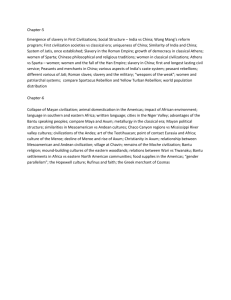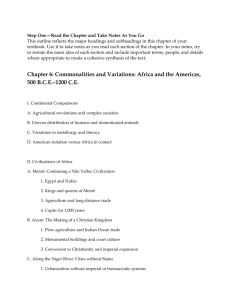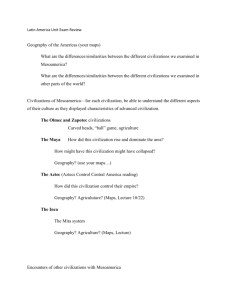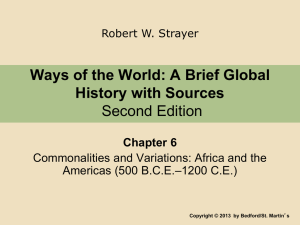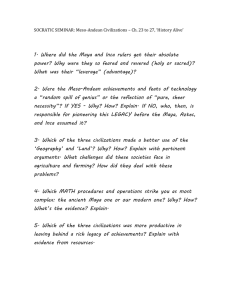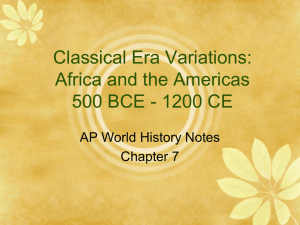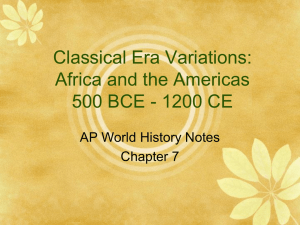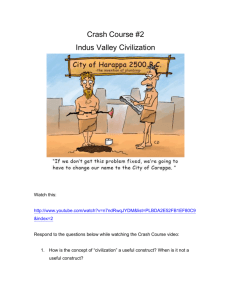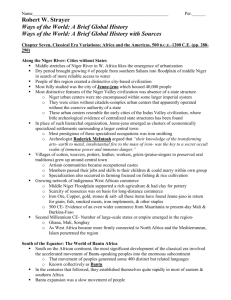File ways of the world chapter 7 study guide
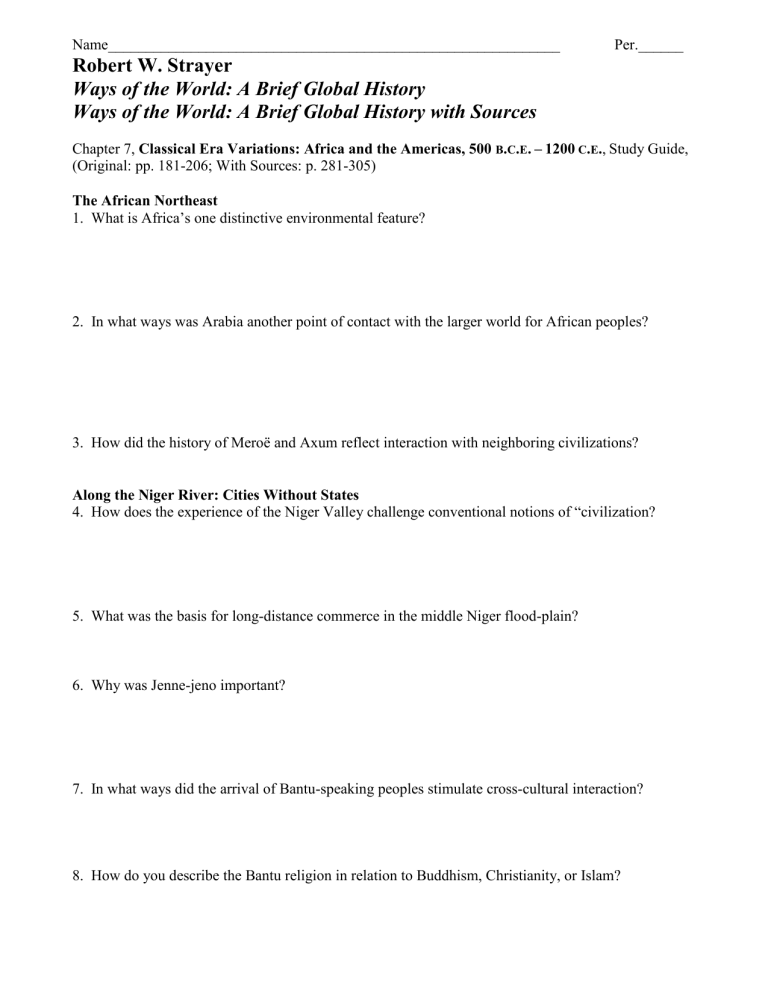
Name____________________________________________________________ Per.______
Robert W. Strayer
Ways of the World: A Brief Global History
Ways of the World: A Brief Global History with Sources
Chapter 7, Classical Era Variations: Africa and the Americas, 500
B
.
C
.
E
.
– 1200
C
.
E
.
, Study Guide,
(Original: pp. 181-206; With Sources: p. 281-305)
The African Northeast
1. What is Africa’s one distinctive environmental feature?
2. In what ways was Arabia another point of contact with the larger world for African peoples?
3. How did the history of Meroë and Axum reflect interaction with neighboring civilizations?
Along the Niger River: Cities Without States
4. How does the experience of the Niger Valley challenge conventional notions of “civilization?
5. What was the basis for long-distance commerce in the middle Niger flood-plain?
6. Why was Jenne-jeno important?
7. In what ways did the arrival of Bantu-speaking peoples stimulate cross-cultural interaction?
8. How do you describe the Bantu religion in relation to Buddhism, Christianity, or Islam?
Civilizations of Mesoamerica
9. Why did the Maya live in an “almost totally engineered landscape?”
10. With what Eurasian civilizations might the Maya be compared?
11. What may have been the ecological and political factors of the Mayan demise?
12. In what ways did Teotihuacan shape the history of Mesoamerica?
Civilizations of the Andes
13. What kind of influence did Chavin exert in the Andes region?
14. What features of Moche life characterize it as civilization?
North America in the Classical Era: From Chaco to Cahokia
15. In what few ways were the histories of the Ancestral Pueblo and the Mound Builders similar to each other?
16. How was the Mississippi River valley, (and the eastern woodlands), different than the Chaco region in the southwest?
17. What are the features of the Hopewell culture?
18. What are the features of the dominant center of Cahokia?
Explain the significance of each of the following:
Coptic Christianity
—
Griots
—
Khiokhoi of South Africa
—
Tikal —
Name________________________________________________________________________ Per.______
Strayer, Ways of the World and Ways of the World: A Brief Global History with Sources
Chapter 7, Classical Era Variations: Africa and the Americas, 500 B .
C .
E .
–
1200 C .
E .
Choose the letter of the best answer. Each answer is worth 10 points.
________1. Which of the following occurrences may have led to the collapse of Maya civilization in the ninth century
C
.
E
.?
(A) A foreign invasion
(B) A century of devastating floods
(C) A long-term drought
(D) Massive peasant rebellions
________2. Which region produced no civilization during the classical period?
(A) South Africa
(B) The Andes
(C)
The Yucatán peninsula
(D) The Niger River valley
________3. Which of the following cultures produced a written language?
(A) Maya
(B) The Niger River valley
(C)
(D)
Moche
Ancestral Pueblo
________4. Which of the following statements best describes the spread of the Bantu peoples to
southern and eastern Africa?
(A) The Bantu spread slowly, often just a few families at a time.
(B) neighbors.
The Bantu were well-armed and quickly able to conquer their
(C) The Bantu migration began quickly but was finally stopped by the powerful forces of Axum.
(D) It was Bantu language and culture that spread, rather than Bantu people themselves, as neighbors emulated highly successful Bantu ways.
________5. How were the Maya and Axum similar?
(A) Both were ruled by a single powerful king
(B) Both possessed written scripts
(C) Both left behind few stone monuments
(D) Both severely limited trade to avoid outside influences
________6. In their political organization of highly fragmented city-states, the Maya were most like
(A) classical Greece.
(B) the Roman Empire.
(C) the Niger Valley civilization.
(D) the kingdom of Axum.
________7. How were Mesoamerican and Andean cultures of the Classical Era similar?
(A)
(B)
(C)
Both were profoundly impacted by the emergence of the Chavín cult.
Both tried but failed to develop regional or long-distance trade networks.
Both were dominated by cities or regional states rather than a single empire.
(D) Both used iron tools extensively.
________8. Both the cultures that took shape in the Chaco canyon region and those that took shape in
the Mississippi River valley
(A) hosted independent agricultural revolutions.
(B)
(C)
(D) adopted maize from Mesoamerica. were inhabited by mound builders. built large cities that rivaled those of Mesoamerica.
________9. Which of the following statements about civilizations of the Andes region is true?
(A)
Only four civilizations developed in this region: the Norte Chico, Chavín, Maya, and Inca.
(B) In the Andean region, it was only possible for people to settle along the coast, where the Pacific Ocean provided both fish and sea birds for them to eat.
(C) Civilizations of the Andean region were politically weak, with limited and highly decentralized state structures.
(D) The need for elaborate irrigation projects helped create strong states in the region.
________10. This classical civilization developed significant cities but no encompassing state
structure.
(A)
Teotihuacán
(B)
Meroë
(C) The Niger Valley
(D) The Maya
